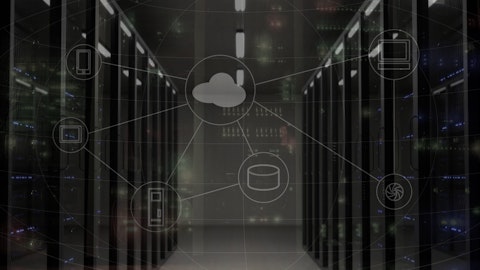Impinj, Inc. (NASDAQ:PI) Q1 2024 Earnings Call Transcript April 24, 2024
Impinj, Inc. beats earnings expectations. Reported EPS is $0.21, expectations were $0.1. PI isn’t one of the 30 most popular stocks among hedge funds at the end of the third quarter (see the details here).
Operator: Hello and welcome to the Impinj First Quarter 2024 Financial Results Conference Call and Webcast. All participants will be in listen-only mode. [Operator Instructions] After today’s presentation, there will be an opportunity to ask questions. [Operator Instructions] Please note this event is being recorded. I would now like to turn the conference over to Mr. Andy Cobb, Vice President, Strategic Finance. Please go ahead.
Andy Cobb: Thank you, MJ. Good afternoon and thank you all for joining us to discuss Impinj’s first quarter 2024 results. On today’s call, Chris Diorio, Impinj’s Co-Founder and CEO, will provide a brief overview of our market opportunity and performance. Cary Baker, Impinj’s CFO, will follow with a detailed review of our first quarter 2024 financial results and second quarter outlook. We will then open the call for questions. Jeff Dossett, Impinj’s CRO, will join us for the Q&A. You can find management’s prepared remarks, plus trended financial data, on the company’s Investor Relations website. We will make statements in this call about financial performance and future expectations that are based on our outlook as of today. Any such statements are forward-looking under the Private Securities Litigation Reform Act of 1995.
Whereas we believe we have a reasonable basis for making these forward-looking statements, our actual results could differ materially because any such statements are subject to risks and uncertainties. We describe these risks and uncertainties in the annual and quarterly reports we file with the SEC. We do not undertake, and expressly disclaim, any obligation to update or alter our forward-looking statements except as required by law. On today’s call, all financial metrics except for revenue, or where we explicitly state otherwise, are non-GAAP. Balance-sheet and cash flow metrics are GAAP. Please refer to our earnings release for a reconciliation of non-GAAP financial metrics to the most comparable GAAP metrics. Before turning to our results and outlook, note that we will participate in Baird’s Global Consumer, Technology and Services Conference on June 4th in New York.
We look forward to connecting with many of you there. I will now turn the call over to Chris.
Chris Diorio: Thank you, Andy, and thank you all for joining the call. 2024 started strong. The momentum we saw exiting 2023 continued through the first quarter, with revenue and profitability exceeding both our fourth quarter results and first quarter guidance. Our strategic focus on silicon and enterprise solutions helped create that momentum while paving the way for multi-year growth tailwinds, while our recent reorganization and legal settlement pave the way for growing profitability. Turning first to silicon, the green shoots I cited the last two quarters continue sprouting. First quarter endpoint IC revenue exceeded our expectations, driven by improving demand in both retail apparel and general merchandise as well as a long tail of other applications.
Looking forward, we expect second quarter to again deliver solid endpoint IC product revenue growth. We also expect Impinj M800 volumes to double in the second quarter as our production ramp picks up, albeit still a small portion of our endpoint IC volumes overall. For reader ICs, we expect E-family shipments to accelerate in the second quarter as we near the end of our prior-generation product shipments, buoyed by a healthy number of design wins and burgeoning opportunities. Turning to solutions, the visionary European retailer’s ongoing rollout of our self-checkout and loss prevention solution is performing nicely, and we expect rollouts at additional brands at that customer to drive modest gateway demand through at least the end of 2024.
Their tagging ramp, which replaces existing hard tags with embedded tags that use our protected mode for consumer privacy, is also on track, driving growing endpoint IC volumes. In general merchandise, the large North American retailer’s RAIN tag usage has accelerated, driven by additional products being tagged and new product ordering. We anticipate steady growth in general merchandise tagging for the remainder of the year. Finally, in supply chain and logistics, we expect the second large North American supply chain and logistics end user to increase their label consumption in 2024. Taken together, our enterprise-solutions efforts are and continue paying clear dividends in endpoint IC volumes. I’d like to now touch on two solutions growth opportunities, Digital Product Passport and food.
On DPP, I recently spent a week in the EU, speaking with partners and end users on how we together advance RAIN as the technology-of-choice for textiles DPP. RAIN has the apparel penetration, but DPP also requires consumer engagement. I see DPP making the strongest case, to date, for putting RAIN reading into the hands of consumers and large enterprises are making that need known. On food, demand is growing at a faster pace than I had expected, with several quick-service food chains talking openly about using RAIN for inventory, shelf life and freshness. The overall food opportunity is so large that any adoption can drive meaningful endpoint IC volumes. On the intellectual-property front, in March we successfully settled our patent dispute with NXP, concluding a multi-year litigation during which Impinj prevailed in multiple jury trials.

As Cary will detail shortly, NXP agreed to pay Impinj an up-front amount and a yearly license fee in exchange for a broad patent cross license. The settlement increases our cash reserves and competitiveness, frees management bandwidth and removes uncertainty from the industry overall. While we are happy to put this dispute behind us, as the RAIN pioneer and innovator we remain vigilant and committed to safeguarding our patented inventions as well as identifying additional licensing opportunities. In closing, we delivered a very strong first quarter in every respect, financial, organizational and market leadership. We see continued strength looking into the second quarter. And looking further out, we see growing opportunities to drive recurring licensing and services revenue; monetizing our IP, platform and cloud services.
As we continue driving our bold vision to connect every item in our everyday world, I remain confident in our market position and energized by the opportunities ahead. Before I turn the call over to Cary for our financial review and second-quarter outlook, I’d like to again thank every member of the Impinj team for your constant effort driving our bold vision. As always, I feel honored by my incredible good fortune to work with you. Cary?
Cary Baker: Thank you, Chris. And good afternoon everyone. On today’s call, I will review our first quarter financial results and second quarter financial outlook. First quarter revenue was $76.8 million, up 9% sequentially compared with $70.7 million in fourth quarter 2023 and down 11% year-over-year from $86.0 million in first quarter 2023. First quarter endpoint IC revenue was $61.5 million, up 14% sequentially compared with $53.9 million in fourth quarter 2023 and down 8% year-over-year from $67 million in first quarter 2023. First quarter endpoint IC revenue exceeded our expectations, led by retail. Looking forward, we expect second quarter endpoint IC product revenue to increase sequentially again led by retail. First quarter systems revenue was $15.3 million, down 9% sequentially compared with $16.8 million in fourth quarter 2023 and down 19% year-over-year from $18.8 million in first quarter 2023.
First quarter systems revenue was below our expectations, primarily due to lower channel reader sales. Looking ahead, we expect a sequential decrease in second quarter systems revenue with increase in channel reader sales more than offset by declining project-based gateway sales. First quarter gross margin was 51.5% compared with 50.9% in fourth quarter 2023 and 52.4% in first quarter 2023. The sequential increase was driven by mix within endpoint ICs. The year-over-year decrease was driven primarily by lower revenue on fixed costs, partially offset by higher systems product margins. Looking to the second quarter, we expect gross margin to increase. Total first quarter operating expense was $32.9 million, compared with $33 million in fourth quarter 2023 and $36.4 million in first quarter 2023.
Operating expense was lower than we anticipated due to strong spend management across all major functions as well as lower litigation costs. Research and development expense was $16.5 million. Sales and marketing expense was $7.7 million. General and administrative expense was $8.7 million, including litigation expense of $1.3 million. We expect a slight sequential decrease in second quarter operating expense as litigation expense declines to immaterial levels more than offsetting investment in our base spend. First quarter adjusted EBITDA was $6.7 million compared with $3 million in fourth quarter 2023 and $8.6 million in first quarter 2023. First quarter adjusted EBITDA margin was 8.7%. First quarter GAAP net income was $33.3 million. First quarter non-GAAP net income was $6.2 million or $0.21 per share on a fully diluted basis.
Turning to the balance sheet, we ended the first quarter with cash, cash equivalents and investments of $174.1 million, compared with $113.2 million in fourth quarter 2023 and $164.7 million in first quarter 2023. Inventory totaled $87.8 million, down $9.4 million from the prior quarter. First quarter net cash provided by operating activities was $60.1 million. Property and equipment purchases totaled $6.2 million. Excluding the $45 million income from the litigation settlement, free cash flow was $8.9 million. Before turning to our guidance, I want to highlight a few items unique to our results and outlook. First, NXP paid us a one-time $45 million litigation settlement payment in the first quarter. We recorded that $45 million in our first quarter GAAP financial statements as other income in our income statement and as cash on our balance sheet.
Next, NXP will pay us an annual license fee each April for up to 10 years unless they design out our IP and exercise an early termination rate. Earlier this month, we received a first $15 million covering the period from April 1, 2024 to March 31, 2025. We will recognize the full value of that payment as second quarter endpoint IC revenue, which is reflected in our second quarter guidance at nearly 100% gross margin. Going forward, the payments will increase annually by a modest fixed rate for as long as the agreement is in effect. As a reminder for calculating our quarterly diluted earnings per share, when quarterly non-GAAP net income exceeds $12 million, you should add the 2.6 million shares underlying our convertible debt into our diluted weighted average shares and you should remove the corresponding $1.2 million of interest expense from our net income.
Finally, first half of 2024 marks a turning point in our operating margin profile. We added high margin licensing revenue and reduced operating expense by removing litigation spend and reorganizing our reader and gateway channel business. As you can see in our second quarter guidance, those actions drive substantial earnings per share accretion and they will also drive significant free cash flow. Furthermore, these margin improvements accrue before the M800 drives additional leverage. Turning to our outlook. We expect second quarter revenue between $96 million and $99 million, compared with $76.8 million in first quarter 2024, a 27% quarter-over-quarter increase at the mid-point, including the license fee payment, and a 7% quarter-over-quarter increase of the mid-point excluding it.
We expect adjusted EBITDA between $23.9 million and $25.4 million. On the bottom line, we expect non-GAAP net income between $21.7 and $23.2 million, reflecting non-GAAP fully diluted earnings per share between $0.72 and $0.77. In closing, I want to thank the Impinj team, our customers, our suppliers, and you, our investors, for your ongoing support. I will now turn the call to the operator to open the question-and-answer session. MJ?
See also 25 Best Countries for Expats With Low Taxes and High Quality of Life and 10 Best Consumer Discretionary Dividend Stocks To Buy According to Analysts.
Q&A Session
Follow Impinj Inc
Follow Impinj Inc
Operator: Thank you very much. We will now begin the question-and-answer session. [Operator Instructions] Today’s first question comes from Harsh Kumar with Piper Sandler. Please go ahead.
Harsh Kumar: Yes. Hey, first of all, guys, huge congratulations, the settlement of the litigation and then also just the turn in the business. Chris, what a big difference six months can make. There’s a lot of interesting stuff in your comments. I wanted to start with general merchandise. I wanted to start with the large North American retailer that you highlighted in your comments. I wanted to ask you how this was going. You obviously talked about some pickup there. Maybe you could just provide us some additional color. And then what is the implication of this implementation succeeding? Is there – is this like a big thing that the entire retail industry is waiting for? Does this have huge implications for adoption for the rest of the retail? And then I’ve got a follow-up.
Chris Diorio: Harsh, appreciate it. I’m going to let Jeff lead in here because he’s very close to customer side, obviously. And so, Jeff?
Jeff Dossett: Yes. Thank you for your question, Harsh. Our tagging ecosystem partners who serve this large North American retailers, tagging needs have signaled steady gains in the tagging of additional general merchandise categories, as well as modest uptick in overall consumer demand. Some of the general merchandise categories are progressing more quickly than others, but we are optimistic that the progress will continue in the year ahead.
Chris Diorio: And Harsh, I’ll add historically that end user has significantly led our industry and others have followed their moves. Of course, there was a setback during the years from 2013 basically to 2019 associated with Round Rock litigation, but that’s well behind us now. And so, although we don’t have firm data to date, it’s my expectation that this customer being a bellwether for many other large customers and for our industry overall has proven historically, and either size, everything they do going forward, I wouldn’t put it, they set the benchmark for other companies to follow.
Harsh Kumar: Very well. Chris, and then for my follow-up guys, I wanted to ask about logistics, again, the second customer that is ramping, do you think you’re in a position to be able to say that this customer will grow with you every quarter, steadily for the rest of the year? And when do you think you might reach the point where you are sort of call it 100% penetrated at this customer and tagging.
Chris Diorio: So I’m going to start here and I’m going to let Jeff jump in, on our scale, we guide one quarter at a time. And with any of these large deployments, there are always teething issues as we go along. We work with the customer and our partners work with customer to get through those teething issues. So there’s always a little bit ups and downs along the way. So it’s difficult for me to say that at any given quarter, things are going to be consistently up. What we do see is strength of that customer, a commitment, a real commitment to go forward and to digitize the entirety of their operations, and a commitment to not only have all the items they transport and move, but also to substantively change how they run their business. And so we see multiple opportunities with this customer and then hopefully with them again, it’s a bellwether for the overall supply chain and logistics industry, others will follow.
Harsh Kumar: Fair enough. I’ll get back in line. Thank you.
Chris Diorio: Thanks, Harsh.
Jeff Dossett: Thanks, Harsh.
Operator: Thank you. The next question comes from Jim Ricchiuti with Needham & Company. Please go ahead.
Jim Ricchiuti: Hi, thanks. Just maybe on that second logistics customer, as you know, I’m sure they discussed moving into this Phase 2 implementation where presumably it sounds like they’re going to be putting readers, RFID readers, in the hands of their drivers. And I assume that’s going to help your reader IC business. But Chris, maybe as we think about their deployment, it moving now into their vehicles, what is the significance of this? Or is this all part of their grand plan that you guys were always kind of aware of?
Chris Diorio: I’m going to let Jeff take the lead here and then I’ll circle back on the impact of silicon.
Jeff Dossett: Yes, I think, first, Jim, I want to reiterate that we prefer to have our existing and prospective end customer speak to their own programs and deployments. But what I will say is that I think we have platform opportunities with this particular customer going forward and importantly, multiple silicon touch points in those opportunities.
Jim Ricchiuti: Got it. And thank you. A follow-up question, Chris, I wanted to go back to your comment about the food applications, moving faster than you expected. How should we think about this? When could this potentially be perhaps a more meaningful incremental driver for the endpoint IC business? I mean, I’m sure it dwarfs. Everything else dwarfs this. But you seem pretty excited about what you’re seeing.
Chris Diorio: I am, Jim. So, if you look back in time, what I said is that food opportunity is so large that it’s hard to see it moving really quickly. And what I’m actually seeing or what I’m feeling is that it’s moving a bit faster than I had expected. And when we see some of the fast food chains talking openly about inventory, shelf life and freshness and we see other opportunities out there on the market on the food front, these are partners bringing in food opportunities. Overall, for me, it’s a little bit of a surprise. It’s just got a quick pace to it and I wasn’t expecting that. Now, part of the reason being that with retail adopting RAIN so successfully, that technology is proven, use cases are proven and it kind of paved the way.
But I still thought things were going to take a little longer. So I’m rather excited by the food opportunities and where they are right now. And as we learn more going forward, we’ll bring other opportunities and insights to your attention.
Jim Ricchiuti: Got it. Thanks. Congrats on the quarter.
Chris Diorio: Thank you.
Cary Baker: Thank you.
Jim Ricchiuti: And the settlement.
Chris Diorio: Thank you very much.
Operator: Thank you. The next question comes from Mike Walkey with Canaccord Genuity. Please go ahead.




